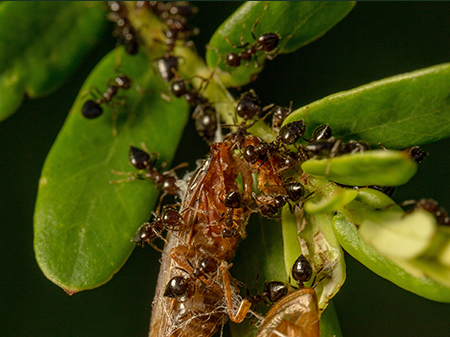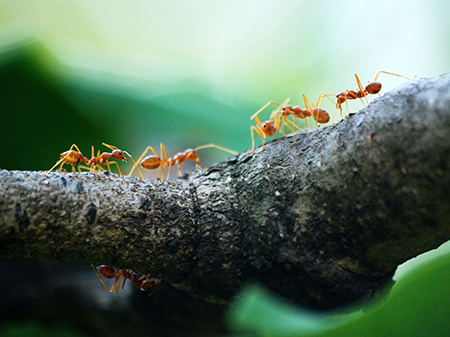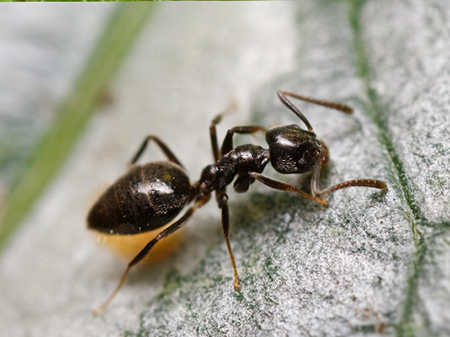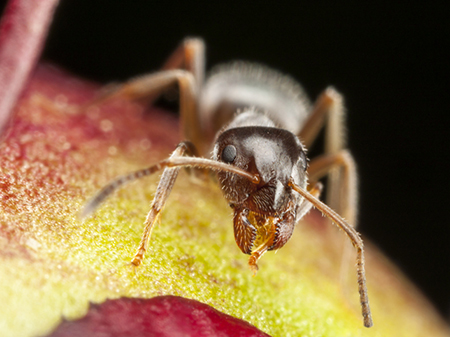Ants
Ants are social insects that live and work together to care for and feed their entire colony, which can be comprised of hundreds to many thousands of members. Ants can be described as nuisance and/or damaging depending on the type of ant and the situation. They are common invaders of homes in Egg Harbor Township, NJ and once these pesky critters establish themselves on a property or inside of a home they are difficult to get rid of without professional help. The most common ants found living in our area include the acrobat ant, carpenter ant, citronella ant, odorous house ant, pavement ant, and pharaoh ant.

Acrobat Ants
The acrobat ant is unique in both its smell and athletic ability. Acrobat ants have the distinct ability to hold their entire abdomen up over the rest of their body in an impressive acrobatic display of flexibility and strength; they most often display this talent when they are being disturbed. In addition, when acrobat ants are disturbed or threatened they emit a very unpleasant smelling odor. Adult acrobat ants range in color from light yellowish-brown to black, though some are multi-colored; they also have a unique “heart-shaped” abdomen which helps in identifying this species of ant. Queens grow to be about 3/8th of an inch in length; while adult workers grow to about 1/8th of an inch in length.

Carpenter Ants
The carpenter ant is one of the largest species of ant found living in the United States. Workers range in size from three-eigths to one-half of an inch in length; queens are large and have the potential to grow up to one inch in length. These ants are most commonly black in color, although some species can be a combination of black, red, and yellow in color. Many people are under the misconception that, like termites, carpenter ants actually eat the wood that they are invading. The truth of the matter is that carpenter ants do not eat wood; they invade wooden structures only to tunnel through them and create nesting galleries for their colony. Termites and carpenter ants are also often confused with each other because to the untrained eye a winged reproduction termite and a winged reproductive carpenter ant look very similar. It is important to understand that both termites and carpenter ants are very damaging and an infestation from either needs to be addressed by a professional as quickly as possible.

Citronella Ants
The citronella ant received its name because of the very strong lemon-like odor that these ants give off when they feel threatened. When these ants are crushed the odor becomes ever stronger and more unpleasant. The color of the citronella ant depends on whether the ant is a worker, male or female; males are black in color, while the workers and winged reproductive females are a lovely golden yellow color. Workers grow to be about ¼ of an inch in length; the reproductive females and males are larger and can grow to between 5/8-inch and 3/8- of an inch in length.

Odorous House Ants
The odorous house ant, stink ant, or coconut ant, as they are commonly referred to, is a very small species of ant, that as their many names describe have the ability to produce a very unpleasant smell. When the odorous house ant is crushed they emit a foul smell that people have likened to the smell of a rotting coconut. Odorous house ants are a very small species of ant with adults only growing to between 1/16th and 1/8th of an inch in length; an interesting fact about these ants is that all members of the colony are about the same size. They range in color from dark brown to black.

Pharoah Ants
The Pharaoh ant was most likely received their name from the popular (mistaken) idea that these ants were one of the plagues of ancient Egypt. Pharaoh ants have pale yellow to red colored bodies, while their abdomens are almost black in color. This is a small species of ant with workers only growing to about 1/16th of an inch in length; queens grow to about double the size of the workers. These ants are a common household invader, but are also extremely problematic inside of hospitals, where they are known to invade patient IVs.
More Facts About Ants
Where do ants nest?
Ants are typically found nesting outside, but often create satellite nests inside of homes and other buildings that are in close proximity to found food sources. However, some species like the pharaoh ants are usually only found nesting inside because of their need for a constant warm temperature. Outside ants can be found nesting in the ground in the soil or sand, in the cracks of cement and pavement, underneath of woodpiles and mulch piles, under fallen trees, in rock piles, under landscaping ties, and in other similar areas. Inside ants usually take up residence in the spaces found behind walls, underneath of floors, behind large appliances, around utility lines and plumbing pipes, and in crawl spaces. Once ants establish a food source that is close to their nest the colony will establish a chemical or “pheromone” trail. The ants will use this trail to easily navigate their way between any food and the safety of their nest.
Why do I have an ant problem?
Ants are attracted to properties and homes that offer them easy access to their basic needs of food, water, and shelter. Outside of your home things that can initially attract ants to your property include unsecured garbage, fruit trees, garden areas, compost piles, pet food, and dripping outdoor faucets or hoses. Inside ants are attracted to homes that provide access to food and water; things like crumbs, spills, and leaky pipes can all cause ants to invade your home. Different species of ants are attracted to different things inside of a home. For example, carpenter ants are attracted to homes that have structural wood that has been damaged by water. Carpenter ants love to nest inside of decaying or water damaged wood. Another example is the pavement ant, they are very attracted to homes that have stone foundations or dirt basements. Also, it is important to understand that many species of ants often invade homes when the weather outside becomes too severe for their liking; weather that is too hot, too dry, or too wet can also drive ants indoors.
Are ants dangerous?
Most people consider ants to simply be nuisance pests, and while it is true that they most are only an annoyance to deal with, the truth of the matter is that they can also be considered dangerous pests. The pharaoh ant is considered to be very dangerous to the health of people because of the fact that they have the potential to carry and transmit salmonella and streptococcus. They are particularly problematic in hospitals where these ants contaminate patient wounds. In homes, they and other species of ants will contaminate food sources with the bacteria found on their bodies.
In addition to health risks, ants can also cause structural damages to homes. The carpenter ant invades a home’s structural wood in order to create tunnels and nesting galleries, and if left untreated the structural damage that they can cause inside of a home can weaken its structural integrity and become very extensive to repair.
How do I get rid of ants?
The first step to getting rid of an ant infestation is to be able to correctly identify the species; some are simply a nuisance, while others like the carpenter ant can be very destructive. Also, carpenter ants and termites are often confused for one another, knowing which you have inside your home is important to ensure that the proper treatment is used to eliminate them. Because most species of ants look similar to each other getting a professional’s input is very important. At Superior Pest Solutions, our professionals will come to your property and perform a detailed inspection to accurately identify the infestation. After the inspection and identification is completed our professionals will treat your home and property, eliminating the infestation and preventing their return. Contact Superior Pest Solutions today to learn more about our comprehensive solution to ants- ant control solutions that can be completed on their own or added on to one of our highly effective year-round pest control offering.
How do I prevent ants?
Ants can be a very difficult pest to prevent, but in addition to putting into place a professional ant control service, the following tips can help to prevent ants from choosing your home and property to invade.
- Make sure that outdoor trash cans are stored away from the outside of your home and that they have tight-fitting or locking lids on them to keep foraging ants out of them.
- Place woodpiles up off of the ground and away from the outside of your home.
- Trim back trees, bushes, and shrubs away from the exterior of your home.
- Quickly pick up fruits or vegetables that have fallen to the ground.
- Seal cracks and crevices found in your home’s foundation, exterior walls, and the spaces found around utilities that are entering into your home.
- Install door sweeps underneath all exterior doors and caulk any gaps found around windows and doors.
- Install de-humidifiers in basement areas to reduce moisture levels in your home; remove any wood from your home that has been damaged by water, replacing it with sound wood.
- Inside your home routinely wash dirty dishes, quickly clean up spills and crumbs, and store food in the refrigerator or in air-tight containers.
- Keep pet food in metal or plastic containers with tight-fitting lids. Pick up uneaten pet food between feedings.
